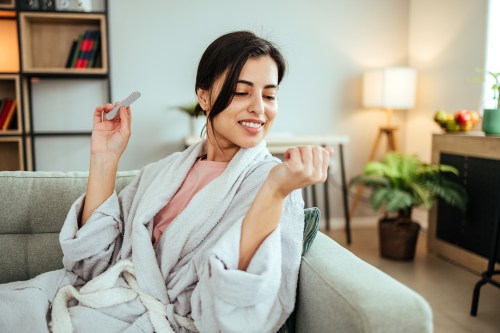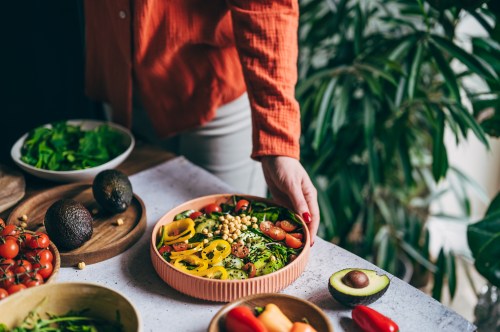What an MD wants you to know about taking bee pollen for allergies
Thinking about taking bee pollen for allergies? Here's what you need to know according to a doc—like how to use it and what types of symptoms it soothes.

There’s a buzzy new ingredient that’s got the wellness world’s attention as of late: bee pollen. You’ve probably seen the crunchy nuggets as the latest garnish atop a smoothie bowl, but it has more purpose than looking good on the ‘gram. In particular, there’s been talk about taking bee pollen for allergies. But before we get to that, let’s step back and discuss what, exactly, bee pollen is in the first place.
Basically, bee pollen feeds a hive (and it’s a superfood for humans, too). To create it, bees collect flower pollen and pack it into small granules using saliva and a bit of honey. It’s chock full of nutrients like protein, amino acids, and a litany of vitamins—and it’s also believed to have powerful anti-inflammatory properties.
Dr. Moday likens the effect of bee pollen to allergy shots, which create resistance against an allergen so the body reacts less when it’s around.
Its ability to fight inflammation is, in part, why people eat bee pollen for allergies. (It goes without saying, but we’re going to say it anyway: You should always consult a doctor before taking anything to treat a medical condition.) That’s because one way to manage allergies—if you have mild symptoms and want to avoid over-the-counter meds because they don’t work or have bothersome side effects—is to help your body build up a tolerance through exposure to the culprit. “The idea is that when you ingest pollen on a daily basis, it’ll desensitize your immune system over time,” says board-certified allergist Heather Moday, MD, owner of Moday Center for Functional and Integrative Medicine in Philadelphia.
Dr. Moday likens the effect of bee pollen to allergy shots, which create resistance against an allergen so the body reacts less when it’s around. “For some people, it’s not going to make much of a difference,” she says. “For others, it may take away symptoms and be a better option than signing up for shots or taking antihistamines.”
Keep in mind, though, that ingesting bee pollen can only help if you have a pollen allergy, so rule this out if you’re plagued with other year-round allergies to certain foods or furry friends. Plus, its effectiveness as a natural allergy treatment hinges on a few things: For starters, Dr. Moday says if you’re severely allergic to pollen and get chronic sinus infections or asthma attacks, this won’t help—in fact, it’s best to avoid ingesting bee pollen to prevent mild reactions, hives—or worse, anaphylactic shock. But if you’re on the less severe side of the seasonal allergy spectrum, regularly eating bee pollen could help quell symptoms like congestion, sneezing, and itchy, watery eyes.
To work, it’s key to eat pollen that contains your specific allergen, so it’s a good idea to get allergy tested to find those triggers. For example, if you have a birch tree pollen allergy, you’d need to eat bee pollen from a hive located near birch trees to feel the difference. Of course, there’s no way to ensure this. Researchers aren’t totally convinced of bee pollen’s ability to relieve allergy symptoms, but small studies have shown a significant decrease in allergy symptoms amongst women who consistently consume bee pollen specific to their allergy.
All regions have different plant life, so buying a jar at a California farmer’s market on a work trip probably won’t help your allergies when you’re back home in New York.
And Dr. Moday says it’s important to eat local bee pollen as it’s more likely to contain your particular allergen from your personal environment. All regions have different plant life, so buying a jar at a California farmer’s market on a work trip probably won’t help your allergies when you’re back home in New York. You can find local bee pollen at farmers markets, specialty food stores, or online. No two bee pollens are the same, so jars contain different colored granules based on what it’s made of, and can taste sweet, nutty or bitter. A word to the wise: Heat renders bee pollen ineffective, so make sure to store it in the refrigerator.
Which brings us to probably the biggest question about taking bee pollen for allergies: How much do you have to eat?
For it to have a chance at being effective, you have to make bee pollen a part of your daily routine in order to build up a tolerance, according to Dr. Moday. Start off with a 1/4 or 1/2 teaspoon and work up to a tablespoon daily—try sprinkling it on top of yogurt, acai bowls, and oatmeal or blending it into your smoothies. “It takes a while for your body to become desensitized,” Dr. Moday says. “This has to be done before the season starts, like a few months out, to really get any response.” If you sprinkle it on your oatmeal every now and again during allergy season, you’ll still be a congested mess. Talk about a buzz kill.
If you’re in need of smoothie recipes, here are 7 savory ones to try until fruit comes back in season.
Sign Up for Our Daily Newsletter
Get all the latest in wellness, trends, food, fitness, beauty, and more delivered right to your inbox.
Got it, you've been added to our email list.










